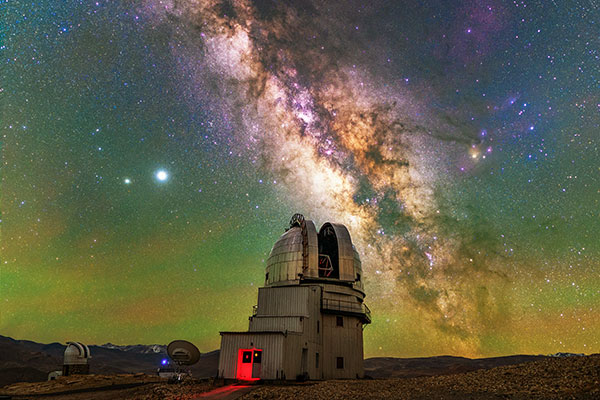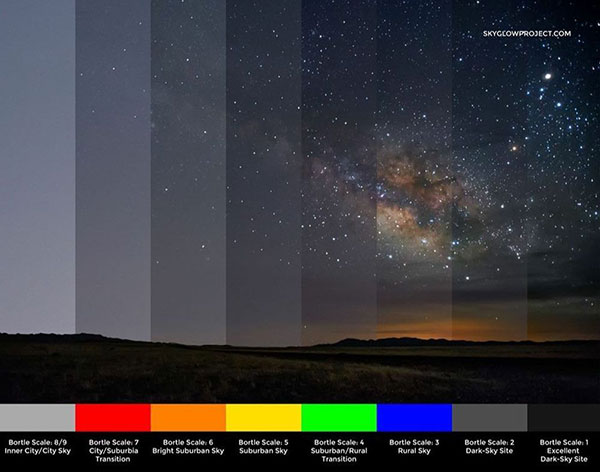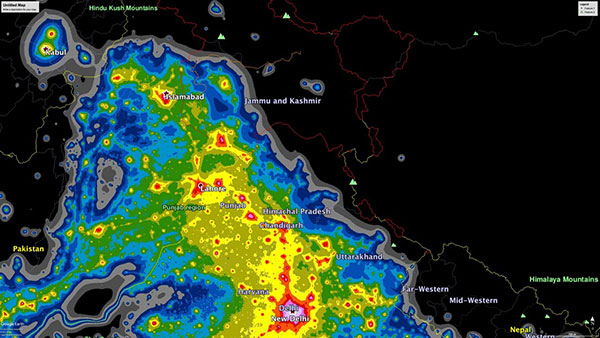Developing Hanle as a dark sky sanctuary

We are currently grappling with electromagnetic and light pollution in addition to other forms of pollution. Each of these forms of pollution have a similar negative impact on our health and environment. While the world at large is taking significant action to reduce the exploitation of nature and reduce pollution, we need to expand these efforts to also address the issue of light pollution.
Current scientific literature suggests that exposure to artificial light at night poses significant risks to human health as it disrupts our sleep patterns. At the same time, the lack of lighting in urban areas has a high correlation with high crime rates. The main challenge here is to limit people’s exposure to artificial light at night while still providing adequate lighting to ensure safety and security.
In this context, unshielded lights remain one of the main challenges. Unshielded lighting wastes illumination as it spreads light over a large area, which is unnecessary. This leads to light pollution, which reduces visibility of stars in the night sky. Outdoor lights should be properly shielded and only used when needed. Furthermore, shielded lights are not only more efficient in providing targeted illumination but also consume less electricity.
Light pollution also has a negative impact on the environment, especially wildlife. Light interferes with the natural day-night cycle i.e. circadian rhythm. Plants use photosynthesis to prepare food during the day and rest at night, similar to humans and other diurnal animals and birds. In contrast, nocturnal animals and birds are active at night and rest during the day. Light pollution wrecks havoc with this natural cycle. Urban lighting has been correlated with the disappearance of many species, and also interferes with the migration of birds and the movement of turtles.
In addition, light pollution also prevents us from exploring the wonders of the universe. Our ancestors have looked skywards since the birth of time in wonderment of the stars, planets and other heavenly bodies that light up the night sky, especially from our own galaxy, the Milky Way. The wonders of the night sky have inspired philosophers, scientists and poets alike through the course of history. However, over the last 100 years or so we have started introducing artificial lights that have prevented us from seeing the night sky for the first time in history. Illumination from urban areas is very intense and light pollution spreads over hundreds of kilometres from their points of origin.
Astronomy is one of the oldest sciences that started a study of objects in the night sky. While astronomers have worked from human settlements for several millennia, increasing light pollution over the last century has pushed them to remote areas where population is sparse and development is limited. Astronomers study the universe by collecting faint light emitted by distant celestial objects. In order to collect such data, astronomers have been forced to establish observatories in remote areas ‘untouched’ by human ‘civilisation’ where the sky has not been polluted by light like our urban areas.

Astronomers have known for several decades that high altitude cold desert conditions like Ladakh have many clear nights and days. Such areas provide ideal conditions for astronomical studies. In the mid-1980s, there was a national effort to identify suitable sites for astronomical studies in India. The Indian Institute of Astrophysics conducted a detailed study of meteorological conditions over the Indian subcontinent and visited six prospective sites. At the end of this study, in 1994 Hanle valley in Changthang, eastern Ladakh was identified as the best site for astronomy in India.

The Indian Astronomical Observatory (IAO) was established on Digpa Ratsa-ri, Hanle in 1997 where the two metre-aperture Himalayan Chandra Telescope was installed in 2000. In addition to astronomy, the observatory has also facilitated studies in geophysics, atmospheric trace gases and aerosols. This has generated employment in Ladakh and created opportunities for Ladakhis to contribute to scientific development through these projects.
Today, Hanle valley is recognised as one of the best sites in the world for astronomical studies along with Mauna Kea Observatory in Hawaii, observatories in the Andean mountains of Chile, and European facilities in the Canary Islands, Spain. The establishment of IAO spurred Chinese astronomers to study sites in their territory and they identified Ngari prefecture in the Tibetan Autonomous Region, adjacent to Hanle, as the best site. An observatory has now been established in Ali in Ngari prefecture along with a dark sky sanctuary around it.
Over the last three decades, Hanle valley has experienced significant changes. Khaldo village near the IAO is one of the fastest-growing hamlets in the Changthang region. In 1994, there were very few settlements around Hanle. As IAO became operational, local settlements also increased in the immediate vicinity. In due course, the number of tourists visiting the valley has increased along with resulting development of tourist infrastructure. Currently, there are five to six commercial establishments in Hanle in the form of guest houses and home stays. While the current growth is concentrated around IAO, future projections suggest significant geographical expansion. Current models suggest that such developmental activities will increase light pollution, which will have a detrimental effect on the astronomical merits of the observatory site.
The modest telescope at Hanle has helped Indian astronomy advance in leaps and bounds since its installation. More facilities are being developed at Hanle that will put IAO on the global map of major astronomical infrastructure. It is hence necessary to protect the area from light pollution like other major astronomical observatories around the world.
In this regard, we must implement a dark sky sanctuary model in Hanle to cover the entire valley from Rongo village to Nilamkhul Plains and the surrounding mountains. Dark sky sanctuaries are generally established in such remote areas around astronomical observatories. In addition to promoting astronomy, such a sanctuary also provides opportunities to tourists and residents to appreciate the night sky as their forefathers, which is impossible in urban areas due to intense light pollution. It also provides a healthy developmental model for biodiversity and human communities.
There is a false notion that the preservation of dark skies requires everyone to turn their lights off and compromise on their security and developmental aspirations. Good lighting policies that protect dark skies also enhance security and support people’s aspirations. They focus on reducing glare, attenuating harsh lighting that creates shadows and focus on targeted lighting and use of adaptive technology to provide lighting solutions. A dark sky sanctuary promotes proper illumination where and when it is needed without wasting energy and polluting other areas, especially the night sky, which does not require illumination.
Reducing artificial illumination at night will also benefit wildlife in the Changthang Wildlife Sanctuary. It will ensure that animals, birds, and humans follow the natural circadian rhythm. The restrictions and improved management of artificial lights will help improve the quality of life for wildlife and humans in the area.
The dark sky sanctuary model provides an alternative to the wasteful and unsustainable urban model of development. It promotes the use of energy-efficient lighting and appropriate shades to illuminate only the required area. Similarly, simple measures such as appropriate curtains over windows can ensure that light does not escape from homes. Outdoor lights can be switched off when everyone is indoors. While night driving is best avoided in a wildlife and dark sky sanctuary, the roads can be painted with fluorescent paints and retro-reflectors to ensure that people can drive with parking lights in case of an emergency. The use of dark sky-compliant lighting will also ensure enormous savings in terms of energy consumption and tariff.
The dark sky sanctuary can also be linked to tourism to create opportunities to educate people about the benefits of dark sky-compliant lighting and lifestyle. Numerous dark sky preserves, sanctuaries, and parks have been established around the world. Dark sky protection has been enforced around most astronomical observatories in the world with an average radius of 30 km while China has established a 2,500 sq km dark sky park in Ngari prefecture around its observatory in Ali.
By preserving the natural conditions of day and night and keeping artificial illumination to the minimum, a dark sky sansctuary enables astronomers to undertake scientific research. They are able to detect the faintest levels and highest sensitivities possible from the Earth’s surface. In addition to environmental and health benefits, such a sanctuary must also help local communities (and tourists) observe and appreciate celestial objects. Facilities can be developed to provide education and awareness on astronomy, ecology and culture through public observatories, museums and planetarium with strict regulation on use of artificial lights. Ethno-tourism can be combined with astro-tourism and eco-tourism to ensure that tourists learn practical measures for sustainable living and locals benefit economically. In time, these strategies to manage light pollution can also be extended to urban areas to improve their night sky visibility.
We must appreciate dark skies and promote dark sky sanctuaries as unique community assets and make them an integral part of our local and national heritage. In addition to the scientific benefits, such an initiative must benefit local communities by creating educational and economic opportunities. Local communities must also be educated and receive incentives to be a part of such efforts.
Photographs, illustrations and text by Dorje Angchuk
Dorje Angchuk is an engineer and astro-photographer

Good effort to preserve it, keep the momentum going to implement innovative way to protect it
Thank you for your comment, Mr Kumar
Nicely written! The fact that we aren’t able to witness the night sky the way our ancestors used to watch and enjoy, is really disappointing. The overall situation is alarming too considering it’s impact on the environment. Thanks for taking a step to create awareness.
Thank you for your comment, Mr Kamat
A very interesting insight into the dark sky sanctuary concept, learnt something new. Very well written article, hope to learn more 🙏🙂
Thank you for your comment, Mr Bajpai
Strong and clear regulations are needed, because once the area is polluted and bright, there is no way back.
Thank you for your comment, Gaspar
Thank u so much🙏🙏 for lightning up us like school students for such a perfect articles n really it’s very interesting!!!
Kasa ju ley Stanzin ley
Sir, really you have covered a adequate large area regarding this issue. Hope our people and most importantly our government will understand the significance of ‘dark sky’ in the field of science as well as our society , and take effective steps soon. We also have to make people aware about this kind of thought by writings, post, campaign etc. Great article.
Thank you for your comment Arjun
Thank you for highlighting light pollution! Since the Hanle area is remote and substantially dark, more than any other observatory location in India, the region already has a head-start, making the task easier. But action is needed before it is too late. On the lines of the Wildlife Protection Act, protection for the darkness of night-sky should be considered, limited to designated areas, like Hanle. The Himalayan sites are indeed community assets and provide opportunities to be developed into multi-wavelength global observatories. For some parts of the electromagnetic spectrum, the high-altitude deserts of the Himalayas may be the only sites with good conditions to host ground based observatory in for the northern skies. Thus, broader action beyond, and including, night-sky protection is called for – declaring these locations as protected science reserves encompassing Himalayan geology, paleontology, wildlife and multi-wavelength astronomy, to mention some areas I can think of. In an even more broader context, Ladakh could be a leader and a model in benign economic development, pursuing avenues with little impact on nature, if careful action is taken.
Thank you
Hello Dorje,
Very nice article and picture.
Did you start already the formal procedure for Ladakh to become an International Dark Sky place?
It seems the procedure is rather long (1-3 years according to https://www.darksky.org/our-work/conservation/idsp/become-a-dark-sky-place/).
Best of luck for this project.